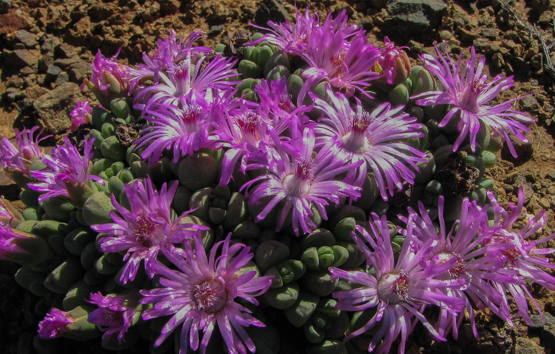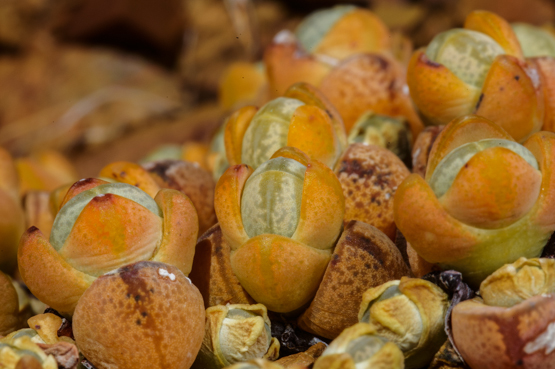Tag: Great Karoo
Anacampseros albidiflora (1)
Lithops localis (2)
Lithops localis (1)
This is the Lithops species with the most southerly distribution area of the whole genus, in the lower Great Karoo from Laingsburg to Steytlerville. It is easily recognized because of the very dense pattern of miniature windows. Mature plants usually have 2-5 bodies, but may occasionally have more than twenty. They flower in April and May.
The naming of the species is a very confusing issue; suffice it to say here that the name L. terricolor is also in use.
All pictures below were taken on the Witteberge plateau south of Laingsburg, very near to the type locality.
No 1: 4 Sept. 2011; no 2: 29 July 2010; nos 3, 4: 21 April 2012
Haworthia viscosa
Although rather variable, this species is easy to identify (H. nigra is the only other Haworthia in which the leaves are arranged in three ranks). The species is tall as Haworthias go: up to 30 cm. It is widely distributed from halfway between Laingsburg and Sutherland, throughout the central, eastern and southern Karoo and the Little Karoo, with an outlying habitat near Graaff-Reinet. In shade the plants are green, but one often encounters them in very arid places in full sun, where they usually become brownish, reddish or orange.
Crassula clavata
Usually the plants show the deep purplish red colours that you see here, in which case they are easy to recognize, but sometimes the leaves are green or yellowish green, making identification less straightforward.
As a rule the leaves are glabrous, but in the isolated Richtersveld populations they are softly hairy. Most of the populations occur in the mountains bordering the Karoo southwards towards Touwsrivier and Prince Albert, in rock crevices and shallow pockets of soil.
The flowers appear in September and October.
Antimima pumila
Although this species sometimes occurs in big colonies, it is nevertheless rather rare, as a result of the limited distribution area (along the border of the winter rainfall area, more or less in the Ceres-Sutherland-Laingsburg triangle). With leaves about a centimeter long, it really lives up to its name (pumila = dwarf).
The difference in appearance between plants in the resting and the growing period is so great that Louisa Bolus described the species twice within two years (as Ruschia pumila and R. levynsiae).
The pictures shown here will hopefully give you a good idea how much the plants change in a couple of months.
The first picture was made at the end of April (= Autumn) and the last one mid November (end of Spring). The flowering plants were photographed end of July-beginning of August.
Anacampseros arachnoides
It is easy to take this species for granted, even in spite of the cobwebby hairs it is decorated with.
The following is a quote from Gordon Rowley’s booklet ” Anacampseros, Avonia, Grahamia. A grower’s Handbook” :
“This attractive and distinctive species seeds itself freely around the glasshouse and has long been cherished or tolerated in collections of succulents. The abrupt tapering of the leaf to a spiny tip is its most distinctive feature”
This sounds to me like a nice example of damning with faint praise.
When one inspects the plants a bit closer, the beautiful, almost reptile-like surface texture of the leaves is revealed. I must confess that since I have discovered this characteristic, I look at these plants with renewed respect.
Brownanthus ciliatus ssp. ciliatus
Together with the other members of the genus this is among the few stem succulents in the family. The short-lived leaves are provided at their base with a fringe of long hairs (cilia = lash).
The plants occur from Calvinia in the north to Ceres in the southwest and Willowmore in the southeast, usually as pioneers on dry flats and on roadsides.
The first picture was made in autumn (4 April 2007), the others in winter (early August to early September 2010).


















































